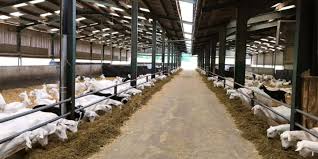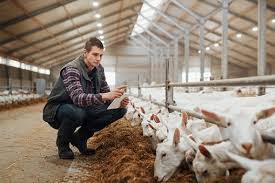In sheep and goat production, housing type depends on the system of production. Each system of sheep and goat production requires different housing needs that is recommended according to the system of production.
Housing Requirements for Sheep and Goat Production
In your previous study, the housing need for ruminant or any farm animal was established as one, for better management in a good environment and two, for safe keeping of the animals and other assets.
The same principle of housing applies to sheep and goat production. However in the tropics, especially in Nigeria and other Sub-Saharan region, housing for sheep and goats is not given prominence as in the temperate region or as even done for cattle.
The main consideration for housing for sheep and goat in this part of the world is to provide sufficient protection from unfavourable weather.
The essential consideration is that the environment must be cool, dry and free from draught with access to pasture or outside all the time.
1. Housing Type for Sheep and Goat under Intensive/Semi-intensive System

In this type of housing, the entire house is well roofed with windows to protect the animals during the winter season in the temperate region. In summer they have access to pasture.
This type of production require a lot of sophistications in the housing construction and very expensive. It is often associated with high level of production in terms of meat, wool or fleece. Such housing is not profitable in this part of the world.
Some government farms or rich individuals do construct a good but simple housing for sheep and goat for semi-intensive production. In this type of housing, a simple building is constructed in which exist slatted floor for the animals to sleep.
Hay racks are provided in some for feeding the animals when they are turned in from the pasture at the end of the day. The roof of the house should not be too high to prevent been blown off by wind nor too short to prevent proper illumination and draught. It is often made of asbestos material or corrugated iron sheet.
Read Also : Management of Breeding Stock in Sheep and Goats
If the latter is used, the wall must not be too high to allow illumination and ventilation. It could also be made of wood, mud or blocks depending on availability of fund. The floor must be sloppy for proper drainage and could be made of concrete or rammed.
The slats could be of bamboo or wood. What is used is a function of the availability of fund. The house could be divided into pens with drinkers and feeders for concentrate feeding.
 Figure: Goat Shed with Slatted Floor
Figure: Goat Shed with Slatted Floor
2. Housing Type for Extensive/Traditional System of Sheep and Goat Production
In this type of production which is common, a simple open shed made of cheap roofing material (thatched roof) provides the expected protection. In most cases the floor is rammed and well drained. In some cases, the animals are tethered behind the house in the open as with subsistent farmers.
For any of these two systems, the floor area require for adult animal range from 1.5m2 to 2.2m2.
In summary, the summary of what you have learnt in this unit are enumerated below:
That the housing need of sheep and goat production depends on the system of production.
That intensive production of sheep and goat is not very common in sub-Sahara region, hence there exist no sophisticated housing as found in the temperate region. What is close to this is a less elaborate housing with slatted or concrete floors often found in government farms and rich individuals with slatted floors.
That the traditional or extensive method housing is simple shed covered with thatched roof and rammed floor.
Read Also : Products that Can be Derived from Agricultural Waste
Frequently Asked Questions
We will update this section soon.

